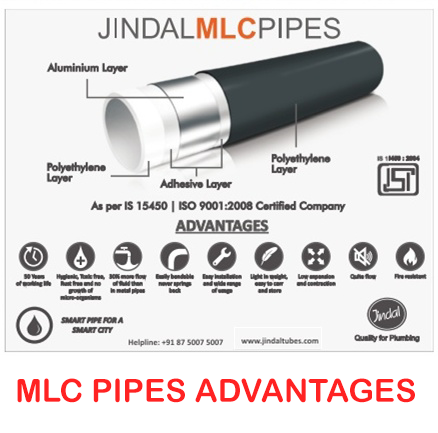“MLC pipe” commonly refers to “Multilayer Composite Pipe.” Multilayer composite pipes are utilized in plumbing and heating systems and are comprised of a couple of layers of various substances. Here are some key traits and records about MLC pipes:

Construction:
MLC pipes are typically composed of three layers:
Inner Layer: Usually manufactured from cross-related polyethylene (PEX) to provide resistance to corrosion and scale buildup.
Middle Layer: Made of aluminum, which adds strength to the pipe and serves as an oxygen barrier to prevent the entry of oxygen into the water, lowering the threat of corrosion in metal additives of the gadget.
Outer Layer: Another layer of PEX for protection and insulation.
Advantages:
Flexibility: MLC pipes integrate the power of plastic (PEX) with the energy of metal (aluminum), making them flexible and smooth to install.
Corrosion Resistance: The inner and outer layers of PEX provide corrosion resistance, making MLC pipes appropriate for diverse water types.
Oxygen Barrier: The aluminum layer acts as an effective oxygen barrier, preventing the ingress of oxygen into the water, that’s essential for hydronic heating structures.

Applications:
MLC pipes are typically used in plumbing and heating packages, which includes underfloor heating structures, radiator connections, and potable water distribution systems.
Installation:
MLC pipes are frequently set up the usage of compression or push-match fittings. The flexibility of the pipe allows for smooth bending and routing, decreasing the want for extra fittings in complex installations.
Standards:
MLC pipes are manufactured to conform with enterprise standards and rules. It’s vital to make sure that the selected MLC pipes meet the important requirements for the supposed application.
Compatibility:
MLC pipes are compatible with numerous styles of fittings and can be used in conjunction with different plumbing substances.
Here are a few additional factors approximately Multilayer Composite (MLC) pipes:

Temperature and Pressure Ratings:
MLC pipes are designed to withstand a number of temperatures and pressures. The precise temperature and pressure rankings can vary based totally at the manufacturer and the intended application. It’s crucial to stick to the producer’s suggestions and standards for the proper use of MLC pipes in distinctive structures.
Jointing Methods:
MLC pipes can be joined the usage of diverse strategies, which include compression fittings, push-suit fittings, and crimping systems. The preference of jointing approach may additionally rely on the particular requirements of the set up and neighborhood policies.
Dimensional Variations:
MLC pipes are available in specific sizes and dimensions to accommodate various plumbing and heating machine requirements. The diameter and thickness of the pipe may additionally range based totally on the meant application and local requirements. Also read this: How to Calculate Cement, Sand, Aggregate ratio of a Concrete
Longevity and Durability:
MLC pipes are recognised for their durability and resistance to corrosion. When properly hooked up and maintained, they can have a protracted service lifestyles. The mixture of substances in MLC pipes helps mitigate issues like scaling and corrosion which could have an effect on traditional metal pipes.
Compatibility with Water Treatments:
MLC pipes are often suitable to be used with water treatments, such as water softeners and other conditioning systems. However, it is critical to consult with the producer to make sure compatibility and to follow any precise recommendations for water remedy.
Installation Guidelines:
Proper installation is essential for the performance of MLC pipes. Installers have to comply with the producer’s installation tips, which may additionally consist of tips for bending radii, assist spacing, and other vital factors.
Hygienic Properties:
MLC pipes crafted from materials like move-linked polyethylene (PEX) commonly have hygienic properties, helping to maintain water nice. They are immune to the boom of micro organism and other microorganisms.
Maintenance:
MLC pipes commonly require minimum preservation. However, periodic tests for leaks, right insulation in uncovered regions, and adherence to any preservation guidelines from the producer are advisable. Also read this: What is M-sand and P-sand ?
Cost Considerations:
While MLC pipes may also have a higher preliminary price in comparison to some traditional piping substances, their durability, ease of set up, and resistance to corrosion can make a contribution to long-term price savings.
Local Code Compliance:
Ensure that the use of MLC pipes complies with local constructing codes and regulations. Codes can also vary through place, and it is crucial to comply with the relevant requirements for plumbing and heating structures.
Always visit nearby government, adhere to enterprise standards, and follow the recommendations of the manufacturer when operating with MLC pipes or another plumbing substances. Check out: Jindal MLC pipe | Whatsapp









